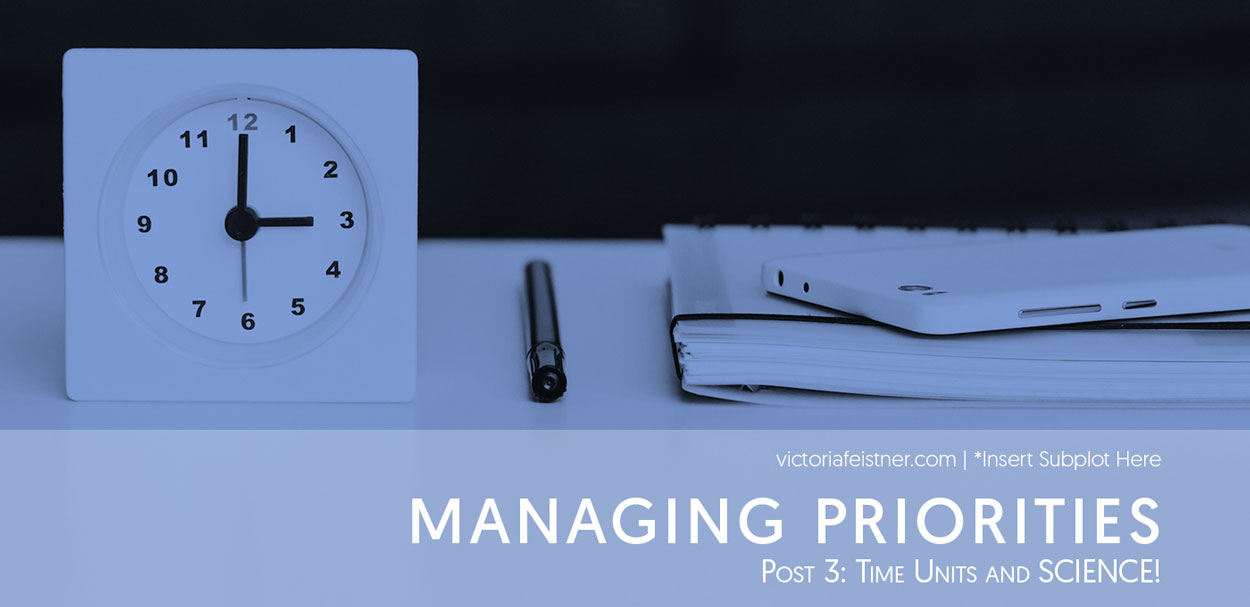This is Part 3 of the Managing Priorities Series. The other parts can be found here: #1, #2, #4, #5
 Last week I showed you my favourite prioritizing methods: KISS, and the Eisenhower Matrix. So you should now have a nice crisp list of verbs and actions arranged in priority. For many people, that’s the only piece they were missing: a idea of where to start. But I know that some of you still need some help. So let’s get going—I’ve only given myself a pomodoro to write this draft!
Last week I showed you my favourite prioritizing methods: KISS, and the Eisenhower Matrix. So you should now have a nice crisp list of verbs and actions arranged in priority. For many people, that’s the only piece they were missing: a idea of where to start. But I know that some of you still need some help. So let’s get going—I’ve only given myself a pomodoro to write this draft!
Timelines Make It An Action Plan
In a perfect list you would go down the items and do them one after another like groceries. But life is messy and projects can be multi-faceted and even the best bread needs to rise. So you’ll need to schedule yourself productively.
But first we need the answer to a bigger question: what’s the largest unit of time that is ‘no big deal’?
As an example, let’s say your verb is to exercise three times a week. An hour a session is standard, right? That’s three hours. But you gotta get to the gym, you need to shower, change, stretch, warm-up… ugh. It’s really more like two+ hours that you’ve then got to find three times a week like some sort of genie. Right? The worst.
But what if we reframe the problem? Instead of three sessions, focus on the ‘three hours per week’. Break that down into chunks. Finding two hours in a day three times a week is hard/impossible, but is finding 30 minutes a day to walk/climb stairs more doable? How about 15 minutes in a morning?
At some point asking yourself these questions you’ll reach a point where the time unit crosses from “hmm, maybe” to “oh yeah, that’s easy”: that’s your largest chunk of ‘no big deal’. For me it’s 15 minutes. Maybe yours is 30 or 45. Maybe it’s less! That’s okay too. The important thing is that reframing a giant task into smaller units of time takes a still-overwhelming action such as “exercise more” into something that can be easily accomplished with a minimum of willpower. If you, say, walk briskly for 15 minutes in the morning and do 15 minutes of jumping jacks in the evening–congrats! You’ve done 30 minutes in a day. Do that every day and you’re actually working out more than your original goal. (Before you @ me, yes, I know, there are different kinds of exercise. The point of this exercise is to show you how to beat procrastination by breaking activities into more digestible chunks.)
I talked about time units last week during the KISS portion of the exercise. That’s where keeping it simple (sweetheart) really becomes powerful: if you go through your list and mark off the items that only take one or two Units to complete, you can likely get them done in the little spaces of time you don’t usually think about, like while waiting for a partner to get out of the shower before heading to brunch or while you’re having your coffee in the morning, or waiting for the streetcar. If you think of a 9-to-5 job (even if you’re working from home, stay with me), even with an hour for lunch and two coffee breaks, that’s 26 15-minute Units. It suddenly seems like much more time than you thought. And if you need a day with an easy ‘win’, you can do all the KISS-marked items first, getting them out of the way, and hopefully helping you feel more in control of your list in the process.
So now that you know what a Unit is, go through your list and estimate how long you think each item will take. If it helps, draw little check-boxes to indicate the units (I draw tomatoes; I’ll cover the Pomodoro technique in greater detail next week). Colouring the boxes in for each Unit can be a little hit of satisfaction to keep you moving down the list.
GOALS NOT DREAMS
What makes a good plan isn’t just a list of priorities, it’s knowing how to schedule yourself. “Goals are dreams plus a deadline” says Abraham Lincoln (source: the internet). We all have things in our lives we have to do whether we feel like doing them or not. But when we have the luxury of scheduling ourselves, we can suit ourselves on the timing, too. Whether you are a morning person or a nightowl or whatever the hell an afternoon person is, chances are there is a time of day where you feel more alert and perky. Where you want to do something. Me, I feel most creative in the mornings, so that’s when I schedule anything that requires me at my most highly-functioning. Afternoons? Not so much, so usually I run errands or do my socializing. Evenings my energy is back up again, so I like to use them for smaller tasks that I didn’t get done during the day or craft projects that bring joy but don’t need to be a priority.
Well super great for you, you’re saying to yourself. It must be fantastic being born with such innate knowledge.
It’s not witchcraft, my friend, nor is it genetics. It’s science.
“Remember, kids, the difference between screwing around and science is writing it down.”
– Adam Savage
Your homework for this week is to keep track of your moods during the day. Write it down in a little notebook or use a note-taking app, which ever makes you happier. Check in with yourself hourly or so, and rate your energy level from zombie to perky (or 1 to 5, if you prefer). It takes a few seconds to jot down the time and your rating, but over the week you’ll begin to see patterns emerge. If you want to go even further and graph your days, go for it! It’s amazing to see your energy levels laid out like some sort of fact and it’ll help you organize your days better. But you can’t organize until you take stock, so get jotting!
The Complete Managing Priorities Series:
Project Managing Yourself | Decluttering Your To-Do List | Time Units and Science! | Work Smarter, Not Harder | Location, Location, Location


5 Comments for "Managing Priorities #3: Time Units and SCIENCE!"